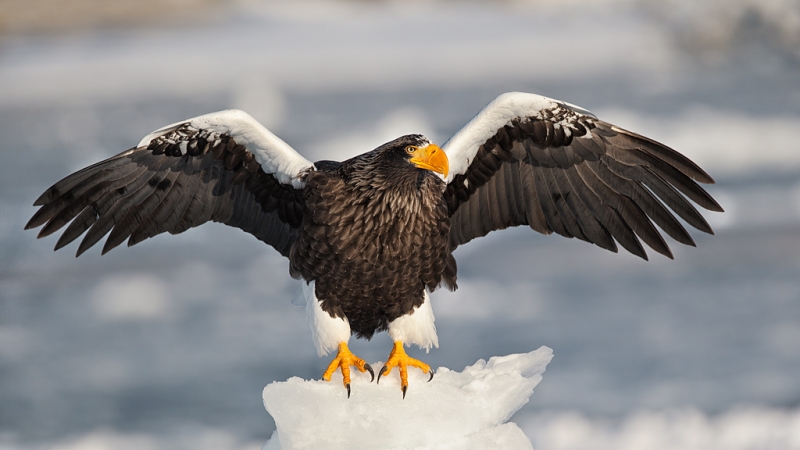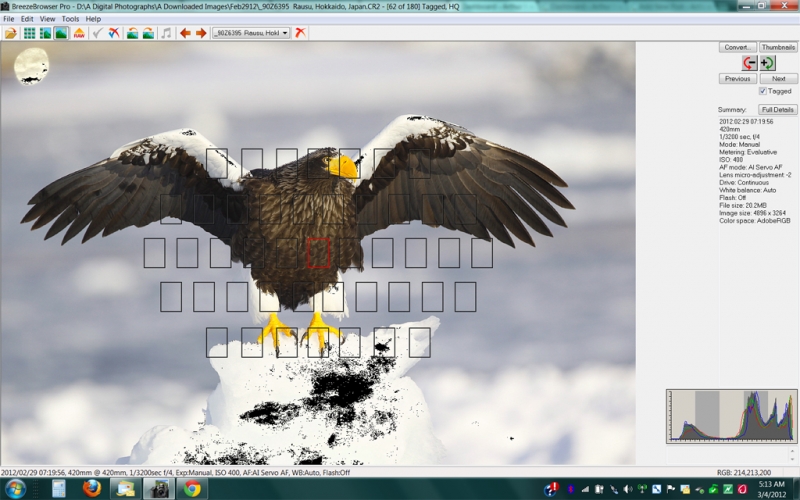Leap Day
Well, I have been around more than 65 years now and I never knew exactly what they called February 29; a Google search turned this up: February 29 is a date that usually occurs every four years, and is called leap day. This day is added to the calendar in leap years as a corrective measure, because the earth does not orbit around the sun in precisely 365 days. When I saw the usually, I pursued the matter further.
Wikipedia revealed this nugget: February 29, also known as a leap day in the Gregorian calendar, is a date that occurs in most years that are evenly divisible by 4, such as 2004, 2008, 2012 and 2016. Years that are evenly divisible by 100, but not by 400, do not contain a leap day; thus 1900 did not contain a leap day while 2000 did. Years containing a leap day are called leap years. The final answer for Alex Trebec: we skip Leap Day once every 400 years.
|
This Steller’s Sea Eagle image was created at 7:20am this past Leap Day at Rausu, Hokkaido, Japan with the hand held Canon 300mm f/2.8 L IS II lens, 1.4X III TC, and the Canon EOS-1D Mark IV. ISO 400. Evaluative metering +2/3 stop: 1/3200 sec. at f/4 in Manual mode. Central Sensor/AI Servo Rear Focus active at the moment of exposure. Click here if you missed the Rear Focus Tutorial. Click on the image to enjoy a larger, more spectacular version. |
The King of Hokkaido
Though making this image did not require the huge leap of faith that I wrote about in the last blog post, A More Aggressive Approach Pays Big Dividends, there is a good chance that I might not have pulled the trigger had my old mind set still been in place. I might have mentioned that I have missed a thousand great images over the decades waiting for the perfect image to become more perfect. That was not the case here: I saw the bird raise its wings, reacted quickly, and made a single image.
See what the folks at BPN had to say about this image and how they helped me improve an already fine image by clicking here. In addition, you can learn a ton by studying the BreezeBrowser Main View screen capture (and my comments) below. Lastly note that the image presented is full frame from side to side with a small crop from the bottom to eliminate the tops of the heads of the two birds along the lower frame edge.
|
Click on the image for a larger, easier-to-read version. |
BreezeBrowser Main View Screen Capture
Note that as mentioned in previous blog posts I pushed the exposure to the right far enough to leave a few blinkies (the black areas) in the snow. As blinkies are only warnings of potential loss of detail those areas were easily saved by moving the exposure slider to the right while holding down the Alt key prior to converting the image in ACR (as described in detail in Digital Basics). Note also that the central AF sensor was on the bird’s breast which was approximately on the same plane as the bird’s eye. And note the crop from below that improved the composition. (See Advanced Composition and Image Design in The Art of Bird Photography II (ABP II: 916 pages on CD only).
Earn Free Contest Entries and Support both the Bulletins and the Blog by making all your B & H purchases here.
More and more folks are earning multiple contest entries with their B & H purchases. See here for details on that. Eleven great categories, 34 winning and honored images, and prize pools valued in excess of $20,000. Click here to visit the competition home page.
Shopper’s Guide
Below is a list of the gear used to create the image above. Thanks a stack to all who have used the Shopper’s Guide links to purchase their gear as a thank you for all the free information that we bring you on the Blog and in the Bulletins. Before you purchase anything be sure to check out the advice in our Shopper’s Guide.
Canon 300mm f/2.8 L IS II lens. The 300 f/2.8 L IS II with the 1.4X III TC is a killer flight combination.
1.4X III TC. The new Series III 1.4X was designed to work best with the new Series II super-telephoto lenses.
Canon EOS-1D Mark IV professional digital camera body. My two Mark IVs are my workhorse digital camera bodies.
And from the BAA On-line Store:
LensCoats. I have a LensCoat on each of my big lenses to protect them from nicks and thus increase their re-sales value. All my big lens LensCoat stuff is in Hardwood Snow pattern.
The Lens Align Mark II. I use the Lens Align Mark II pretty much religiously to micro-adjust all of my gear an average of once a month and always before a major trip. Enjoy our free comprehensive tutorial here.
Canon EOS-1D Mark IV User’s Guide. Learn to use your Mark IV the way that I use mine. Also available for the 7D and the Mark III here.
BreezeBrowser. I do not see how any digital photographer can exist without this program.
















Re: I held the lens elevated for extended periods of time. When I got back to the motel and took off my sweatshirt I could barely lift my arms; I was very much in pain.
With one f/4 exception, all your shots with that lens were at f/5 of above.
I realize that you are not likely to look into a micro 4/3 camera, where the 100-300mm f/4 – 5.6 Panasonic Lumix lens has twice the frame filling ability of a 300mm on full frame … and weighs 1.5 pounds.
However, your relationship with Canon and your shoulder issue do make you the ideal candidate to lobby Canon to address your needs for professional quality in a smaller, lighter system. It will be interesting to see what they come up with.
What a wonderful image. I think those sea eagles alone would have been worth the price of the trip. Also great to know that you post on BPN and learn from the feedback.
David
Been doing that since James Shadle and I founded BPN almost three years ago. It is the premier nature photography learning site on the planet and we are very proud of it.
Superb! The biggest Eagle in the world looks about ready to carry off an iceberg!!
I was also reading the Wiki on leap days this week. Qi = ( Quite interesting. )
Artie; Just wondering why you were set at ISO 400 rather than 200 in this instance? It looks like ISO 200 would have given you 1/2500th if I am not mistaken, and that should have been enough shutter speed. I know this is a grey area and that being on 400 (as I think I would have been too actually) is safer, but I would really like to hear your thinking in setting 400 rather than 200 in this area where either one probably works. I am assuming you think the safety of a slightly higher shutter speed outweighs the potential benefit in less noise from a lower ISO? Thanks for all your great tips and lessons! Richard
I have just begun working at ISO 200 in some sunny situations but old habits die hard. And I love ISO 400. I see no discernible differences in color or noise (with properly exposed images). And I have some hawk photographer friends who believe that no shutter speed is too high for flight photography….
Every 400 years, there are 97 leap years…not 100. Take as an example the four hundred years 2000 thru 2399 inclusive, all years evenly divisible by 4 are leap years EXCEPT 2100, 2200, and 2300. This is because years beginning a new century must also be evenly divisible by 400 (4 X 100). Therefore there will be exactly 97 leap days (February 29) every 4 centuries.
So, Art, every 400 years, Leap Day is skipped 303 times. I believe this is the accurate Jeopardy answer.
You are correct on both counts.
The pics from Japan brings back memories as I was one of the first troops in Japan after they surrendered. Bought my first camera for 2 cartons of cigs. and a lighter. Camera was not automatic anything and no instruction book. Had fun learning and finally managed to get some decent pics. Still have them even to this day. ( Film came at one extra pac.) Wonder if B&H got started this way.
God bless you. My Dad lost his right arm just before that on Okinawa.
We skip leap day three times every 400 years!
I reread the Wikipedia stuff and realized that you are correct sir. Thanks! My bad: I flunked the MENSA quiz!